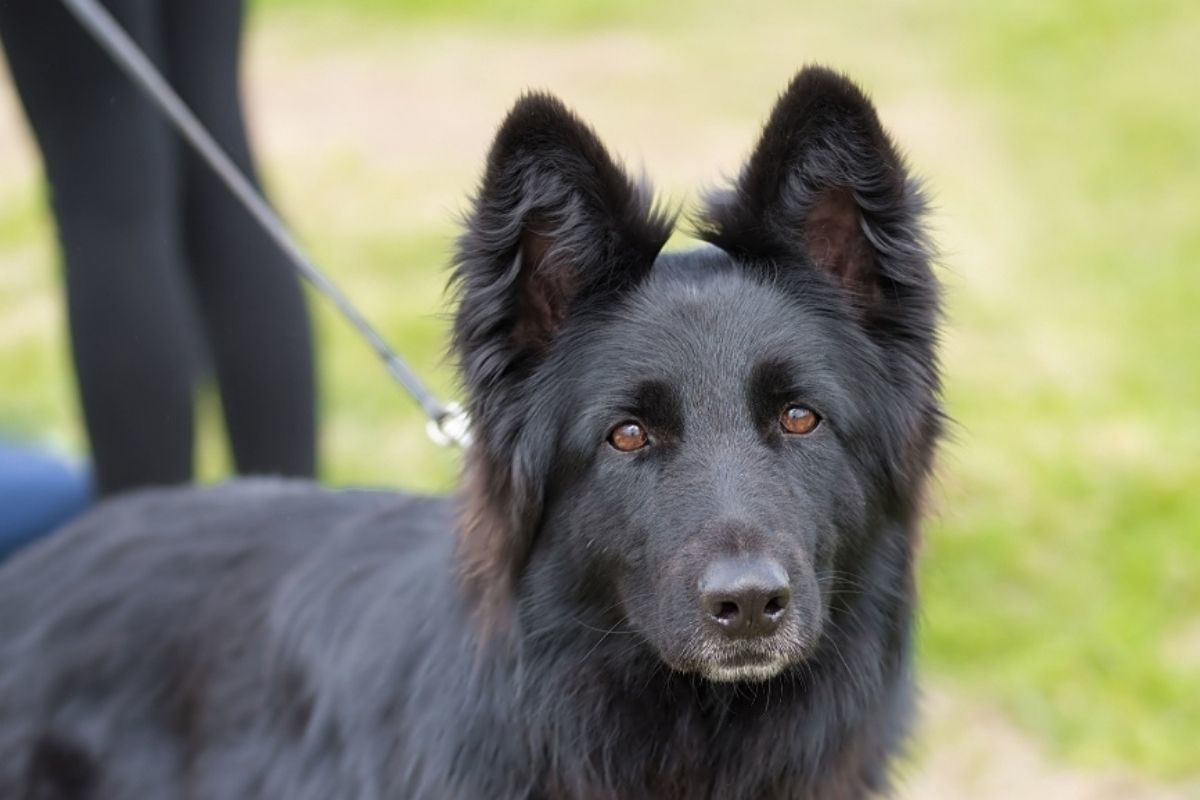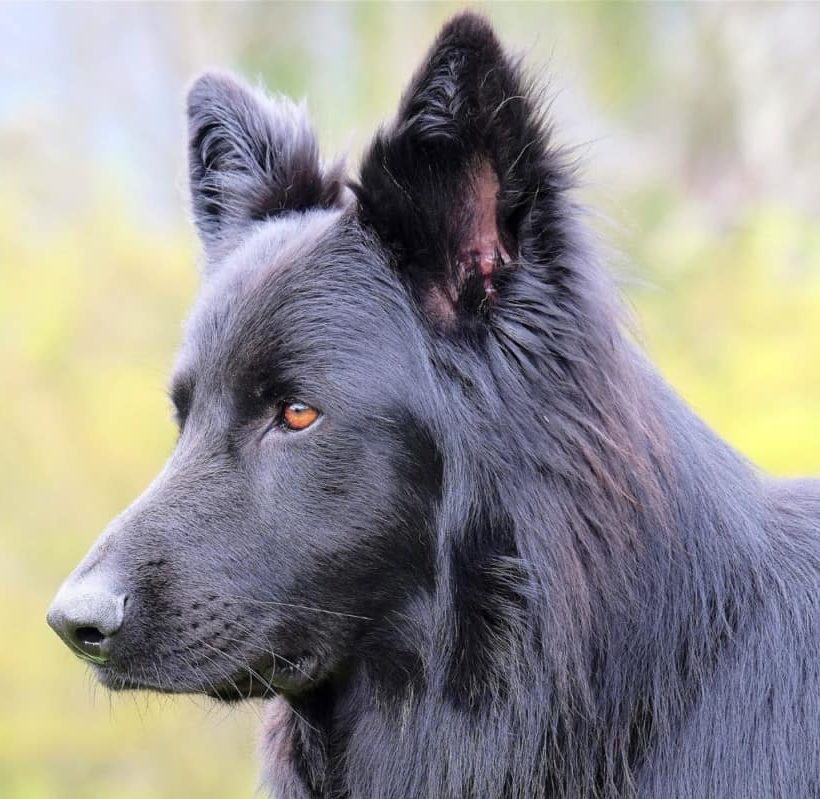Embark on a journey into the rare and fascinating world of Blue German Shepherds, a lesser-known but equally majestic variant of the beloved German Shepherd breed.
This blog post is dedicated to unraveling the mysteries behind the unique blue coat color of these dogs due to a specific genetic trait.
Known for their intelligence, loyalty, and versatility, German Shepherds are a favorite among dog lovers, and the Blue German Shepherd adds an extra layer of allure with its distinctive appearance.
Whether you’re a German Shepherd aficionado, are considering adding a Blue German Shepherd to your family, or are simply intrigued by this unusual coloration, I’ll provide you with insightful information about their genetics, temperament, and overall care.

What is a Blue German Shepherd?
A blue German Shepherd is a GSD with a double recessive D (dilute) gene, which results in a diluted black color, making the dog’s coat appear visibly blue.
They are not a separate breed – but paler variants of black GSDs and have just the same temperament and health as other varieties.
Since they aren’t an individual breed, the history of blue German Shepherds is no different from that of German Shepherds.
They originated in the 19th century in northern Germany when a German Cavalry Officer named Max von Stephanitz bred the best canines from different districts for four decades to engineer the German Shepherd.
Blue German Shepherds: A Brief Overview
| Blue German Shepherd | Breed Characteristics |
|---|---|
| AKC Group | Herding |
| Origin | Germany |
| Type | Companion / Working |
| Breed Size | Medium to Large |
| Height | 24-26 inches (Males) 22-24 inches (Females) |
| Weight | 66-88 pounds (Males) 49-71 pounds (Females) |
| Temperament | Brave, Protective, Guard-dog, Athletic, Strong, Confident, Intelligent, Alert, Independent, Faithful, High-energy, Aloof, Devoted, Versatile, Territorial |
| Appearance | Strong, Agile, Long Muzzle, Bushy Tail, Pointy Ears, Noble |
| Lifespan | 10-13 years |
| Health Issues | Bloat (GDV), Hip Dysplasia, Degenerative Myelopathy |
| Coat Colors | Blue-gray |
| Coat Type | Short, Plush (Medium), Long, Double-coated |
| Shedding | Heavy |
| Grooming | Moderate |
| Easy to Train | Yes |
| Exercise Needs | Medium-high |
| Hypoallergenic | No |
| Child Friendly | Yes |
| Pet Friendly | Yes |
| Good for new owners | Yes |
| Cost | $1500 to $2500 |
Since the GSD is a cocktail of canine genetics, it isn’t peculiar to see multiple colors across the breed going from sable to red, black, silver, and tan. Blue German Shepherds are not sky blue or even navy blue.
They are just diluted black German Shepherds with entirely inactive D genes. When this gene is active, it introduces a full black color.
Geneticists express an active gene with capital letters and an inactive one with lowercase letters. So, “d” is responsible for blue, whereas “D” is responsible for black.
However, genes exist in pairs, and even a single D in the pair introduces the dominant all-black color. Most black GSDs have a DD pair, but only in a genetic context.
Here are the gene pairs a dark GSD can have.
- DD – Full black coat.
- Dd – Full black coat; the recessive blue is taken over by black.
- dd – Diluted black, i.e., blue color.
In other words, if we treat blue GSDs as a breed, we must look specifically at all-black German Shepherds, which are often working lines.
Max Von Stephanitz named this breed Deutscher Schäferhund, which translates to “German Shepherd Dog.” The name owes to their original purpose of protecting sheep and assisting shepherds in herding.
Technically, all GSDs should have been working line dogs. But what caught on was the dog’s beauty, which branched into the show line.
Working line dogs can be born blue, making them look quite important. They are called blue German Shepherds because of their distinctive blue/grey coat color and lighter eyes.
They are acquired with the same motivation as a show line dog: to have a dog that the owner finds visually aesthetic.
However, one can make the case that blue GSDs are bought with even purer intentions. That’s because one might buy a show line GSD even if he doesn’t like the dog’s color to introduce the dog at a pageant.
Learn More About the Blue German Shepherd In Our Video…
Blue GSDs aren’t allowed in the show ring in the USA, as per the breed standard. This means such a dog is bought out of pure love and a genuine, deeply personal appreciation of his looks.
They can, however, participate in other events such as agility, scent work, and IPO.
Coat Color Variations
The American Kennel Club rated the German Shepherd the fourth most popular dog breed in the US in 2022.
Blue German Shepherds are even more popular amongst enthusiasts because of their seemingly magical fur with a bluish-grey tinge, making them a sight to behold.
Although they are working line dogs in every other aspect, their stunning coloration sets them apart and is the primary reason behind their popularity.
Apart from their distinctive coat color, the pigment for their noses, eye rims, and paw pads is also steel grey-blue. But ultimately, they are liked for their exceptional temperament, obedience, and intelligence when trained right.

If you get this variety, you’ll not get a dog that is any easier or harder to train than the average German Shepherd.
The average GSD and the blue German Shepherd do not exhibit any stark differences except their coat color. They are the same breed with the same characteristics.
So, if you choose based on the dog’s looks (a valid rationale), you must ensure you know your options aside from blue.
The most common coat colors for average German Shepherds are black and tan, but black and cream, black and red, black and silver, and bi-color combinations are also present.
1. Blue German Shepherds Are Rare
Although the blue German Shepherd carries the same characteristics and temperament as the standard German Shepherd, they are much rarer because of the odds of two recessive (dd) genes pairing up.
Both parents must be carriers of the recessive gene for a blue GSD puppy to be born.
Moreover, because blue is not allowed in the show ring and is still considered a fault, even though the AKC has recently recognized this coloration, most breeders do not intentionally breed this color.
Thus, fewer blue dogs are produced, mainly because breeders can genetically test for Dilute (D Locus/Blue).
2. They Have a Distinct Appearance

Blue German Shepherds look like working-line German Shepherds with a lighter black color that borders on blue. The dog’s color is not sky blue or blue in the traditional sense.
Instead, you’ll notice only a hint of the bluish tint on an otherwise deep grey coat.
Although the blue coat appears like a washed-out black or shade of grey, it can have different variations, including solid blue, saddle, bicolor, or sable. Light powder blue or dark steel blue are some other color variations.
The color does not seem intimidating or scary but rather quite magnificent. These pups might not be the best show dogs, but they’ll be your breathtaking friends with people turning heads.
The coat color of a German Shepherd Dog is a variation determined by genetics.
There are two types of genes in action; the first indicates the color of the fur, and the other decides the presence or absence of markings and their distribution on the dog.
The inheritance of the double recessive gene creates a blue German Shepherd, which also contains a dilution gene working as a modifier at its center.
This dilution gene affects eumelanin (the very dark pigment in black coats), and thus, the blue color can have four pattern variations: Solid blue, blue bicolor (with minute tan points), blue and tan, and blue sable.
Common misconceptions about this breed include that they can come in a blue and black pattern, which is impossible genetically. The dilution genes that cause blue coloration will affect all-black coloring, not just certain areas.
Some blue German Shepherds have blue eyes, but not all of them. Even if a puppy is born with blue eyes, the trait may or may not be permanent.
Since the dog possesses a recessive gene that decides his eye color, he may grow to have the usual dark eyes. Many will have light or amber eyes.
They have a medium or a long double coat with a dense guard layer and a softer undercoat to keep them warm.
They have a dome-shaped head with a long, square muzzle and erect ears with solid necks. Many of their characteristics are often said to resemble their wolf ancestors.
A standard-sized male blue German Shepherd grows 24 to 26 inches or 60 to 66 cm tall and weighs around 65 to 90 lbs or 29 to 40 kg. Females grow to be 22 to 24 inches or 55 to 60 cm tall and weigh about 50 to 70 lbs or 22 to 31 kg.
Since color is not a factor in determining the size of a German Shepherd, you can expect all breeds to be around this size.
German Shepherds are medium to large dogs and hardly ever make good apartment pets as they require considerable space.
3. Blue German Shepherds Are Expensive
Although breeders should charge different prices for different colors, they charge higher for blue German Shepherds because of their rarity and unusually striking color.
Blue German Shepherds cost from $1500 and can go up to $2500 or even higher if a dog possesses a champion pedigree. On the other hand, the adoption fee for this variation ranges from $50 to $350, but blue GSDs can be pretty hard to find in adoption centers.
Since tan and black are more common and celebrated in German Shepherds, most breeders opt for this popular variation instead of breeding for the unique blue color. The rarity of this variation adds to its price.
Dogs with impressive pedigrees may be closer to $5,000, and those possessing show line or protection dog line traits may have an even higher price range.
However, since blue GSDs aren’t ideal for American dog shows, they are still cheaper for how rare they are.

4. They Are Purebred
Many controversies exist around the coat color of a blue German Shepherd. One of these is whether they are pedigree or mixed breed.
So what’s the deal?
Blue German Shepherds are purebred. They can appear in a litter of purebred pups and are as genetically pure as the others.
They are identical to other GSDs except for their blue coats caused by a recessive gene and are recognized by the American Kennel Club but disqualified from the show ring.
Still, some breed purists believe they should never be bred because their blue color is merely a gene mutation. Others believe that despite their unusual color, they should still be allowed to enter the show ring.
Since their blue color is only a variation of coat color, it does not indicate the inclusion of any other breeds in the line.
Although some intentional breeders may be available, they would be pretty rare. The only way to guarantee a blue GSD is to mate two blue parents with two recessive dd genes.
Solid black dogs possess DD or Dd genes, which are not suitable for breeding blue puppies.
Dd German Shepherds can’t be distinguished from DD Shepherds, so there is a possibility that a breeder might mate Dd and Dd GSD, and the offspring might have a dd pair, turning blue.
5. The Blue Color Does Not Influence Behavior
The blue coat color of blue GSD is filled with controversies and misunderstandings. Some people assume that if a dog has two recessive gene units, he might have undergone severe inbreeding.
So what’s the bottom line?
Some suspect the blue GSD has specific genetic defects, which is untrue. The color holds just one meaning: the gene that caused it was recessive.
This variation possesses characteristics and traits similar to other types of German Shepherds.
In all observable settings, blue German Shepherds are no different from standard black GSDs in anything but color. And all black GSDs are no different in temperament from any other type.
Among the myths about blue GSDs is that they get angry quite quickly. However, they do not have anger issues and are incredibly loving dogs.
However, they have strong, possessive traits, and their owner-pleasing quality can make them anxious and even destructive if left alone for long periods. But these, again, are working-line GSD traits, albeit under biased scrutiny.
Since they were the guardian of their flock in their herding days, their possessive nature is not uncalled for. Although this can be an undesirable quality sometimes, you can manage it with socialization and positive reinforcement from a young age.
Blue GSDs are very family-oriented dogs and make excellent pets. They are known for being alert and watchful and consider protection their duty.
They are also highly trainable and loyal, making them the perfect family dog, good watchdogs, and working dogs.
They tend to be aloof with strangers, but you can rectify that with extensive socialization and proper training. They also have separation anxiety, but there are many preventive steps that you can take to ensure their well-being when left alone.
Remember, blue German Shepherds are medium to high-energy dogs like other variations of German Shepherds and require at least 90 minutes of exercise a day filled with highly interactive games or high-intensity activities.
They also need mental stimulation during the day because of their high intelligence.
6. The Blue Color Does Not Affect Health
The blue color in a German Shepherd is simply a feature. No substantial evidence indicates any health issues or problematic personality traits that come with this coloration.
Although the diluted genes can cause color dilution alopecia in Dobermans and some other breeds, blue German Shepherds do not suffer from this issue.
Therefore, their color is a mere overall variation as their health and temperament match other GSD variations.
Health Issues
The blue German Shepherd Dog is not prone to behavioral or temperamental complications stemming from his color. Although it may indicate certain traits in the health of other breeds, this is not the case with blue GSDs.
Even though considered a healthy breed, they suffer from specific health problems like all German Shepherds.
Elbow dysplasia and hip dysplasia are the most common health concerns. Dysplasia is a disease of a malformation of the joints seen in many large dogs and causes joints to become painful and worsen over time, resulting in lameness.
Since blue GSDs are bred from a single bloodline, they face other genetic mutations.
These concerns include degenerative myelopathy, a slow, non-painful degradation of the spinal cord, and congenital heart defects such as aortic stenosis, pulmonic stenosis, and patent ductus arteriosus.
7. Care Requirements are the Same as Other Types
Blue German Shepherds are high-energy dogs, just like every other type of GSD. Even mini-German Shepherds exhibit the same energy level and need as much activity as a standard GSD.
You don’t have to cross off a blue GSD from your list if you live in an apartment. Blue GSDs may live in apartments if you provide them the required stimulation and space to explore.
However, landed properties and homes with more space are better options. Having a spacious home isn’t all you need, though.
Dedicated training and socializing are unavoidable for these dogs as they are prone to separation anxiety and aggressiveness if chained up.
They are significant responsibilities; you should only take them in if you can be assertive and naturally like large dogs.
FAQs
What is the rarest color of a German Shepherd?
The rarest color of a German Shepherd is Isabella. They are also known as lilac German Shepherds. Their color is due to the recessive combination of blue and liver from their parents.
The liver gene prevents all black pigment, giving the dog a diluted coat color. As a result, they won’t have any black on their paw pads, noses, or eye rims. Isabellas typically have hazel or light blue eyes.
Can a full-blooded German Shepherd have blue eyes?
Full-blooded German Shepherds can have blue eyes, but it is extremely rare. The blue eye color is due to a recessive gene that needs to be inherited from both parents, and it is considered a genetic mutation. While many dog owners find the trait attractive, most breeders consider it a fault.
Can you show a blue German Shepherd?
A blue German Shepherd cannot participate in conformation shows, as they do not adhere to the German Shepherd breed standard of the AKC. However, blue German Shepherds can still compete in other types of dog shows, such as obedience and agility competitions.
Final Thoughts
You should only get a blue GSD if you are naturally interested in the breed overall. You must handle and control them, be patient for consistent training and reinforcement, have free time for daily exercise, and have ample living space.
Although blue German Shepherds are extremely intelligent, loyal, magnificent-looking, devoted, and protective dogs, they are heavy shedders with extensive training and care requirements.
Therefore, you should not take them in for merely aesthetic purposes as they are not just a fashion statement and come with significant responsibilities.
Related Posts You May Like:





